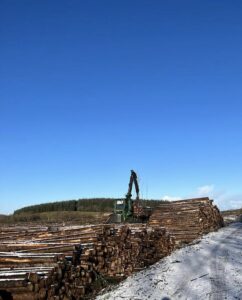Timber Harvesting in Ireland
Timber harvesting plays a crucial role in Ireland’s forestry sector, contributing to both economic growth and environmental sustainability. Timber harvesting practices in Ireland is influenced by several factors and this brief insight will explore the most recent guidelines and practices in timber harvesting in Ireland, highlighting the efforts made to balance economic interests with environmental concerns.
Sustainable Forest Management
Ireland has a long history of afforestation, with approximately 11% of its land area covered by forests. Sustainable forest management (SFM) is at the core of Ireland’s timber harvesting guidelines. Under SFM, forests are managed to provide a wide range of economic, social, and environmental benefits while ensuring the long-term health of forest ecosystems. Key elements of SFM include:
- Forest Certification: Many forests in Ireland are certified under programs like the Forest Stewardship Council (FSC) and the Programme for the Endorsement of Forest Certification (PEFC), with the majority of the forest in the public sector managed under these stewardship standards. These certifications ensure that timber is sourced from sustainably managed forests. Political efforts along with an interest from private forestry companies are supporting a drive for privately managed woodlands to achieve sustainable forest certification.
- Selective Logging: Timber harvesting in Ireland often follows the principle of selective logging otherwise known as “Thinning”. This means that only specific trees are harvested while leaving others to grow on to maturity, ensuring the continuity of the forest ecosystem. This is done in some cases up to 4 times until the trees are ready for clearfelling.
- Biodiversity Conservation: The recent guidelines emphasize the importance of conserving biodiversity within forested areas. Special attention is given to protecting habitats and endangered species.
- Regeneration: After clearfell harvesting, forests are regenerated through natural or artificial means to ensure a steady supply of timber, along with preserving and developing improved animal habitats and the welfare of the forests surroundings.
Environmental Considerations
Ireland’s timber harvesting guidelines prioritise environmental conservation and sustainability. Measures are in place to minimise the negative impact of logging activities on ecosystems, water quality, and air quality:
- Buffer Zones: Buffer zones are established along water bodies to prevent soil erosion and protect water quality. This reduces the risk of sedimentation and pollution.
- Sensitive Areas: Harvesting is restricted or prohibited in ecologically sensitive areas such as wetlands and protected habitats.
- Reforestation: Afforestation efforts are ongoing to replace harvested trees and restore forests.
- Wildlife Protection: Guidelines emphasise protecting wildlife habitats and ensuring that harvesting activities do not disturb or harm native wildlife.
Economic Sustainability
Timber harvesting in Ireland is a significant contributor to the national economy. The most recent guidelines aim to strike a balance between economic sustainability and environmental conservation:
- Economic Benefits: Ireland’s forest sector makes a €2.3 billion contribution to the economy and employs 12,000 people all across the country. These are rural jobs in a sustainable industry that is an important part of Ireland’s economy. Timber harvesting provides jobs, income, and revenue for rural communities. It also supports the forest-based industries, including sawmills and wood processing facilities.
- Timber Markets: The guidelines encourage the development of robust timber markets to ensure a steady demand for harvested wood. This expands into the international market where Irish timber products are used, not just internally within Ireland, but are also exported across all areas of the world.
- Forest Inventory: Regular assessments of forest inventory are conducted to determine the sustainable yield, ensuring that harvesting does not exceed what the forests can regenerate.
Community Engagement
Community engagement is a crucial aspect of Ireland’s timber harvesting guidelines:
- Stakeholder Consultation: Local communities, environmental organisations, and industry stakeholders are consulted in the planning and decision-making processes.
- Education and Awareness: Efforts are made to educate the public about the importance of sustainable forestry and the benefits it brings to local communities.
Conclusion
Ireland’s timber harvesting guidelines reflect the country’s commitment to balancing economic growth with environmental sustainability. Sustainable forest management principles, environmental considerations, economic sustainability, and community engagement are at the heart of these guidelines. Ireland’s forests are not only valuable resources for timber production but also critical for biodiversity conservation, carbon sequestration, and recreational activities. By adhering to these guidelines which are a key aspect in Ireland’s plans to reducing their carbon emissions targets, Ireland is working towards a future where its forests thrive while providing sustainable economic and environmental benefits for generations to come.
Visit our websites at
www.ForestryServices.ie www.Ashdieback.ie www.Euroforestireland.ie


